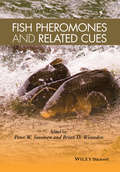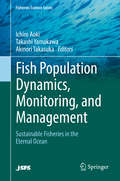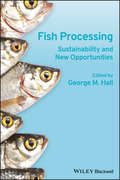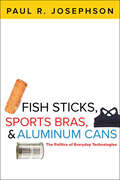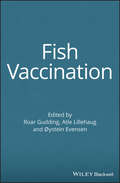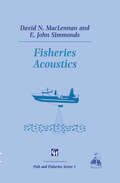- Table View
- List View
Fish Pathology
by Ronald J. RobertsFish Pathology is the definitive, classic and essential book on the subject, providing in-depth coverage across all major aspects of fish pathology. This new, fully updated and expanded fourth edition builds upon the success of the previous editions which have made Fish Pathology the best known and most respected book in the field, worldwide.Commencing with a chapter covering the aquatic environment, the book provides comprehensive details of the anatomy and physiology of teleosts, pathophysiology and sytematic physiology, immunology, neoplasia, virology, parasitology, bacteriology, mycology, nutritional pathology and other non-infectious diseases. A final chapter provides extremely useful details of the most widely-used and trusted laboratory methods in the area. Much new infomation is included in this new edition, including enhanced coverage of any diseases which have become commercially significant since publication of the previous edition Beautifully illustrated in full colour throughout with many exceptional photographs, Fish Pathology, Fourth Edition, is an essential purchase for fish pathologists, fish veterinarians, biologists, microbiologists and immunologists, including all those working in diagnostic services worldwide. Personnel working in fish farming and fisheries will also find much of great use and interest within the book's covers. All libraries in universities and research establishments where biological and veterinary sciences are studied and taught should have copies of this landmark publication on their shelves.
Fish Pheromones and Related Cues
by P. W. Sorensen Brian D. WisendenPheromones are chemical cues that pass between members of the same species that convey specific, adaptive information. These cues, and related chemicals whose function are less well defined, are especially important to fishes because of their aquatic environments and complex behaviors. Pheromones are also of increasing interest in both basic and applied aspects of fish biology because they can be used to manipulate fish behavior and may explain phenomena such as fishery collapse. Fish Pheromones and Related Cues provides a timely synthesis of this growing body of research in freshwater and marine species and explores everything from how these chemical signals evolved, are produced, released and then processed, and finally to potential applications in fish culture and conservation. Fish Pheromones and Related Cues opens with a useful overview on the theory of chemical communication and definitions. Chapters then progress by examining the biological importance of pheromones in inter- and intra-species communication, the role these chemical cues play in a variety biological functions from reproduction to predation, and then how they evolved and are detected and recognized by fish nervous systems. Final chapters provide valuable insight into how pheromones can be measured, how pheromonal disruption can explain effects of environmental pollution, and lastly how they pheromones are being applied in real-world efforts to culture fish species and to conserve our wild populations and control invasive species. With far-reaching economic, evolutionary and ecological implications, Fish Pheromones and Related Cues will be an essential volume for anyone working in the fields of chemical communication, fish biology, fisheries science, aquatic conservation, ecology, invasive species control, and aquaculture
Fish Pheromones and Related Cues
by Peter W. Sorensen Brian D. WisendenPheromones are chemical cues that pass between members of the same species that convey specific, adaptive information. These cues, and related chemicals whose function are less well defined, are especially important to fishes because of their aquatic environments and complex behaviors. Pheromones are also of increasing interest in both basic and applied aspects of fish biology because they can be used to manipulate fish behavior and may explain phenomena such as fishery collapse. Fish Pheromones and Related Cues provides a timely synthesis of this growing body of research in freshwater and marine species and explores everything from how these chemical signals evolved, are produced, released and then processed, and finally to potential applications in fish culture and conservation. Fish Pheromones and Related Cues opens with a useful overview on the theory of chemical communication and definitions. Chapters then progress by examining the biological importance of pheromones in inter- and intra-species communication, the role these chemical cues play in a variety biological functions from reproduction to predation, and then how they evolved and are detected and recognized by fish nervous systems. Final chapters provide valuable insight into how pheromones can be measured, how pheromonal disruption can explain effects of environmental pollution, and lastly how they pheromones are being applied in real-world efforts to culture fish species and to conserve our wild populations and control invasive species. With far-reaching economic, evolutionary and ecological implications, Fish Pheromones and Related Cues will be an essential volume for anyone working in the fields of chemical communication, fish biology, fisheries science, aquatic conservation, ecology, invasive species control, and aquaculture
Fish Population Dynamics, Monitoring, and Management: Sustainable Fisheries in the Eternal Ocean (Fisheries Science Series)
by Ichiro Aoki Takashi Yamakawa Akinori TakasukaThis book explores how we can solve the urgent problem of optimizing the use of variable, uncertain but finite fisheries resources while maintaining sustainability from a marine-ecosystem conservation perspective. It offers readers a broad understanding of the current methods and theory for sustainable exploitation of fisheries resources, and introduces recent findings and technological developments. The book is divided into three parts: Part I discusses fish stock dynamics, and illustrates how ecological processes affecting life cycles and biological interactions in marine environments lead to fish stock variability in space and time in major fish groups; small pelagic fish, demersal fish and large predatory fish. These insights shed light on the mechanisms underlying the variability in fish stocks and form the essential biological basis for fisheries management. Part II addresses the technologies and systems that monitor changes in fisheries resources and marine ecosystems using two approaches: fishery-dependent and fishery-independent data. It also describes acoustic surveys and biological sampling, as well as stock assessment methods. Part III examines management models for effectively assessing the natural variability in fisheries resources. The authors explore ways of determining the allowable catch in response to changes in stock abundance and how to incorporate ecological processes and monitoring procedures into management models. This book offers readers a broad understanding of sustainable exploitation as well as insights into fisheries management for the next generation.
Fish Processing: Sustainability and New Opportunities
by George M. HallThis book seeks to address the challenges facing the international seafood industry via a two pronged approach: by offering the latest information on established technologies and introducing new ideas and technologies. An introductory chapter sets the tone for the book by presenting the background against which fish processing will exist in the near future. Chapter two looks at the environmental and sustainability issues relating to conventional fish processing, including processing efficiency and better use of the outputs currently considered wastes. The impact of mechanisation and computerisation on environmental sustainability is also addressed. Subsequent chapters examine the latest developments in established fish processing technologies such as canning, curing, freezing and chilling, with an emphasis on the environmental aspects of packaging and the process itself. In addition, quality and processing parameters for specific species, including new species, are described. The second part of the book gives authors the opportunity to introduce the potential technologies and applications of the future to a wider audience. These include fermented products and their acceptance by a wider audience; the utilisation of fish processing by-products as aquaculture feeds; and the use of by-products for bioactive compounds in biomedical, nutraceutical, cosmetic and other applications.
Fish Processing: Sustainability and New Opportunities
by George M. HallThis book seeks to address the challenges facing the international seafood industry via a two pronged approach: by offering the latest information on established technologies and introducing new ideas and technologies. An introductory chapter sets the tone for the book by presenting the background against which fish processing will exist in the near future. Chapter two looks at the environmental and sustainability issues relating to conventional fish processing, including processing efficiency and better use of the outputs currently considered wastes. The impact of mechanisation and computerisation on environmental sustainability is also addressed. Subsequent chapters examine the latest developments in established fish processing technologies such as canning, curing, freezing and chilling, with an emphasis on the environmental aspects of packaging and the process itself. In addition, quality and processing parameters for specific species, including new species, are described. The second part of the book gives authors the opportunity to introduce the potential technologies and applications of the future to a wider audience. These include fermented products and their acceptance by a wider audience; the utilisation of fish processing by-products as aquaculture feeds; and the use of by-products for bioactive compounds in biomedical, nutraceutical, cosmetic and other applications.
Fish Processing Technology
by George M. HallAs with the first edition this book includes chapters on established fish processes and new processes and allied issues. The first five chapters cover fish biochemistry affecting processing, curing, surimi and fish mince, chilling and freezing and canning. These established processes can still show innovations and improved theory although their mature status precludes major leaps in knowledge and technology. The four chapters concerned with new areas relevant to fish processing are directed at the increasing globalisation of the fish processing industry and the demands, from legislation and the consumer, for better quality, safer products. One chapter reviews the methods available to identify fish species in raw and processed products. The increased demand for fish products and the reduced catch of commercially-important species has lead to adulteration or substitu tion of these species with cheaper species. The ability to detect these practices has been based on some elegant analytical techniques in electrophoresis.
Fish Reproductive Biology: Implications for Assessment and Management
by Tore JakobsenFish recruitment is a key process for maintaining sustainable fish populations. In the marine environment, fish recruitment is carried out in many different ways, all of which have different life history strategies. The objective of this book is to argue for greater linkages between basic and applied research on fisheries recruitment, and assessment and management of exploited fish stocks. Following an introductory chapter, this second edition of Fish Reproductive Biology is organized into 3 main sections: Biology, Population Dynamics and Recruitment Information Critical to Successful Assessment and Management Incorporation of Reproductive Biology and Recruitment Considerations into Management Advice and Strategies The authors collectively bring a wide range of diverse experience in areas of reproductive biology, fisheries oceanography, stock assessment, and management. Fully updated throughout, the book will be of great interest to a wide audience. It is useful as a textbook in graduate and undergraduate courses in fisheries biology, fisheries science, and fisheries resource management and will provide vital information for fish biologists, fisheries scientists and managers.
Fish Reproductive Biology: Implications for Assessment and Management
by Tore Jakobsen Michael J. Fogarty Bernard A. Megrey Erlend Moksness"The economic importance of fishes and their societal and cultural relevance provide powerful incentives for large-scale, sustained studies of their dynamics" —the Editors The overall goal of this book is to give a picture of the present use of information on fish reproductive biology in assessment and management and its potential for improving management of these resources. Compiled by an international team of authors, each an expert in their field, this exceptional volume is divided into three major sections: Biology, population dynamics, and recruitment Information critical to successful assessment and management Incorporation of reproductive biology and recruitment considerations into management advice and strategies Including over 100 diagrams, this book is essential reading for all fisheries scientists. Libraries in universities and research establishments where this subject is studied and taught should have copies on their shelves. "As one author put it: the goal is to facilitate a 'dialogue between assessment scientists and biologists.' Readers of any specialty should accept this challenge, and this book is an excellent resource to aid them." —Fisheries, March 2010
Fish Reproductive Biology: Implications for Assessment and Management
by Tore Jakobsen Michael J. Fogarty Erlend Moksness Bernard A. MegreyFish recruitment is a key process for maintaining sustainable fish populations. In the marine environment, fish recruitment is carried out in many different ways, all of which have different life history strategies. The objective of this book is to argue for greater linkages between basic and applied research on fisheries recruitment, and assessment and management of exploited fish stocks. Following an introductory chapter, this second edition of Fish Reproductive Biology is organized into 3 main sections: Biology, Population Dynamics and Recruitment Information Critical to Successful Assessment and Management Incorporation of Reproductive Biology and Recruitment Considerations into Management Advice and Strategies The authors collectively bring a wide range of diverse experience in areas of reproductive biology, fisheries oceanography, stock assessment, and management. Fully updated throughout, the book will be of great interest to a wide audience. It is useful as a textbook in graduate and undergraduate courses in fisheries biology, fisheries science, and fisheries resource management and will provide vital information for fish biologists, fisheries scientists and managers.
Fish Sticks, Sports Bras, and Aluminum Cans: The Politics of Everyday Technologies
by Paul R. JosephsonWho would have guessed that the first sports bra was made out of two jockstraps sewn together or that it succeeded because of federal anti-discrimination laws? What do simple decisions about where to build a road or whether to buy into the carbon economy have to do with Hurricane Katrina or the Fukushima nuclear disaster? How did massive flood control projects on the Mississippi River and New Deal dams on the Columbia River lead to the ubiquity of high fructose corn syrup? And what explains the creationâ€�and continued popularityâ€�of the humble fish stick? In Fish Sticks, Sports Bras, and Aluminum Cans, historian Paul R. Josephson explores the surprising origins, political contexts, and social meanings of ordinary objects. Drawing on archival materials, technical journals, interviews, and field research, this engaging collection of essays reveals the forces that shape (and are shaped by) everyday objects. Ultimately, Josephson suggests that the most familiar and comfortable objectsâ€�sugar and aluminum, for example, which are inextricably tied together by their linked history of slavery and colonialismâ€�may have the more astounding and troubling origins. Students of consumer studies and the history of technology, as well as scholars and general readers, will be captivated by Josephson’s insights into the complex relationship between society and technology.
Fish Structural Proteins and its Derivatives: Functionality and Applications
by Maya Raman Dhanya Pulikkottil Rajan Abhilash Sasidharan S. SabuThis book brings out a comprehensive collection of information on the structural proteins of fish in both marine and fresh water system. The main focus of this book is to address all relevant aspects of structural proteins of fish and its commercial significance. Fish is a rich and cheap source of protein, and the collagen and myofibrillar proteins, play a key role in food and pharmaceutical industries. Marine-based collagen due to its unique properties have fewer risks of transmitting diseases. These have low molecular weight, are biocompatible, lack religious constraints, and involves cost-effective extraction process. Therefore, it finds wide biomedical applications. The details of its extraction, isolation and characterization, supported with photographs and flow-charts are provided. This book also discusses the different peptides and derivatives of proteins that may have beneficial health significance and other commercial importance. Further, the application of bioinformatics and artificial intelligence in understanding the protein structure in-silico are also discussed in detail. This book is of interest and useful to students, academician, researchers and industrialists/ entrepreneurs, and is a valuable source of reference to the relevant researchers/ students.
Fish Vaccination
by Roar Gudding Atle Lillehaug Øystein EvensenFish farming, in seawater and in freshwater, in cages, tanks or ponds, makes an ever-increasing and significant contribution to the production of aquatic food in many regions of the world. During the last few decades there has been significant progress and expansion in the aquaculture sector, characterized by intensified production and the exploitation of many new species. Aquaculture must be a sustainable bio-production, environmentally as well as economically. Disease prevention in order to reduce losses, and the use of antimicrobials is crucial in this perspective. Vaccination has, in a few years, become the most important method for disease prevention in aquaculture, and effective prophylaxis based on stimulation of the immune system of the fish is essential for further development of the industry. This book provides general information about disease prevention in fish by vaccination, as well as specific descriptions of the correct use of vaccines against the most important bacterial and viral infectious diseases of aquatic animals. The book is written by some of the world’s leading experts in the subject, drawn from many countries where aquaculture is a significant and expanding part of the economy. Fish Vaccination is an encyclopedia of fish vaccinology for every present and future aquaculturist. Professionals in the aquaculture sector, including fish veterinarians and fish biologists, within the industry, in scientific institutions and regulatory authorities will all find a huge wealth of commercially important knowledge within this book. Libraries in all universities where aquaculture, biological and veterinary sciences are studied and taught should have copies of this important book on their shelves.
Fish Vaccination
by Roar Gudding Atle Lillehaug Oystein EvensenFish farming, in seawater and in freshwater, in cages, tanks or ponds, makes an ever-increasing and significant contribution to the production of aquatic food in many regions of the world. During the last few decades there has been significant progress and expansion in the aquaculture sector, characterized by intensified production and the exploitation of many new species. Aquaculture must be a sustainable bio-production, environmentally as well as economically. Disease prevention in order to reduce losses, and the use of antimicrobials is crucial in this perspective. Vaccination has, in a few years, become the most important method for disease prevention in aquaculture, and effective prophylaxis based on stimulation of the immune system of the fish is essential for further development of the industry. This book provides general information about disease prevention in fish by vaccination, as well as specific descriptions of the correct use of vaccines against the most important bacterial and viral infectious diseases of aquatic animals. The book is written by some of the world’s leading experts in the subject, drawn from many countries where aquaculture is a significant and expanding part of the economy. Fish Vaccination is an encyclopedia of fish vaccinology for every present and future aquaculturist. Professionals in the aquaculture sector, including fish veterinarians and fish biologists, within the industry, in scientific institutions and regulatory authorities will all find a huge wealth of commercially important knowledge within this book. Libraries in all universities where aquaculture, biological and veterinary sciences are studied and taught should have copies of this important book on their shelves.
Fish Viruses and Bacteria: Pathobiology and Protection
by Associate Professor Arun Dhar Andrew Orry F C Allnutt Dr Scott LaPatra Richard Whittington Dr Jo-Ann Leong Dr Gael Kurath Dr John S Lumsden Dr Paul Hick Dr Ellen Ariel Dr Mamoru Yoshimizu Dr Hisae Kasai Dr Yoshihiro Sakoda Dr Nanako Sano Dr Motohiko Sano Dr Knut Falk Dr Maria Aamelfot Dr Peter Dixon Dr David Stone Dr Lester H. Khoo Dr Rodman G. Getchell Dr Geoffrey H. Groocock Dr Keith Way Dr Anna Toffan Dr Yasuhiko Kawato Dr Kuttichantran Subramaniam Dr Kazuhiro Nakajima Dr Thomas Waltzek Dr Marius Karlsen Dr Renate Johansen Dr Bjarnheidur K. Gudmundsdottir Dr Bryndis Bjornsdottir Dr Larry A. Hanson Dr Matt J. Griffin Terence Greenway David J. Wise Thomas P. Loch Mohamed Faisal Esteban M. Soto David T. Gauthier Martha W. Rhodes John P. Hawke Jerri Bartholomew Kristen D. Arkush Diane G. Elliott Craig A. Shoemaker De-Hai Xu Alicia E. Toranzo Beatriz Magariños Ruben Avendaño-Herrera Timothy J. Welch David P. Marancik Christopher M. Good Michael Ormsby Robert DaviesTaking a disease-based approach, Fish Viruses and Bacteria: Pathobiology and Protection focuses on the pathobiology of and protective strategies against the most common, major microbial pathogens of economically important marine and freshwater fish. The book covers well-studied, notifiable piscine viruses and bacteria, including new and emerging diseases which can become huge threats to local fish populations in new geographical regions if transported there via infected fish or eggs. A concise but thorough reference work, this book: - Covers key viral and bacterial diseases of notable fish species; - Reviews major well-established piscine pathogens as well as new, emerging and notifiable diseases; and - Contains the most up-to-date research contributed by a team of over fifty world experts. An invaluable bench book for fish health consultants, veterinarians and all those wanting instant access to information, this book is also a useful textbook for students specializing in fish health and research scientists initiating fish disease research programmes.
Fish Waste to Valuable Products (Sustainable Materials and Technology)
by Sajid Maqsood Muhammad Nihal Naseer Soottawat Benjakul Asad A. ZaidiThis book provides a comprehensive overview of recent developments to valorize fish waste as a source of useful products. In the first few chapters, an introductory section unearths global fish waste production, its detrimental effects and its role in the circular economy. The next section of the book discusses recent applications of fish waste and by-products utilization for the production of useful products such as fertilizers, biogas, biodiesel, fish sauce, enzymes and many more. This book will serve as an important source of recent research developments and applications of fish waste generated at different stages of fish processing. This book will also act as an important reference to the research group conducting research on fish and fish by-product utilization and valorization.
Fish Welfare
by Edward J. BransonFish have the same stress response and powers of nociception as mammals. Their behavioural responses to a variety of situations suggest a considerable ability for higher level neural processing – a level of consciousness equivalent perhaps to that attributed to mammals. Each chapter of this book has been written by specialists in their field. The subject matter is wide ranging and covers in detail concepts of animal welfare in addition to more specific aspects of fish welfare. Philosophical concepts of welfare are discussed along with more practical areas of fish welfare encompassing all husbandry and management activities that have a potential to affect the welfare of the fish in our care. This book is an essential purchase for fish veterinarians, fish farmers, fish biologists and those involved in the aquaculture industry and its regulation.
Fishbowl
by Matthew GlassThe internet is everywhere. Those who control it, control us.As a gifted Ivy League student, Andrei Koss hit upon an idea that would revolutionise social networking and move it on by a generation. Enlisting the help of his best friends, Ben and Kevin, he turned their dorm room into an operations base, where flashes of creative brilliance and all-night-coding sessions led to the creation of Fishbowl. He is now the 21-year-old CEO of a multi-billion-dollar empire. His creation reaches into every corner of the planet. But its immense power has many uses, and some will stop at nothing to get a piece of it.
Fisheries Acoustics: Theory and Practice (Fish and Aquatic Resources)
by John Simmonds David N. MacLennanLiving resources of the sea and fresh water have long been an important source of food and economic activity. With fish stocks continuing to be over-exploited, there is a clear focus on fisheries management, to which acoustic methods can and do make an important contribution. The second edition of this widely used book covers the many technological developments which have occurred since the first edition; highly sophisticated sonar and computer processing equipment offer great new opportunities and Fisheries Acoustic, 2e provides the reader with a better understanding of how to interpret acoustic observations and put them to practical use. Well known and respected authors Emphasis on practical acoustic methods Detailed coverage of a commercially and environmentally important subject A vital tool for fisheries scientists, fisheries oceanographers, environmental biologists, ecologists, population biologists, fish biologists, and marine biologists. All those involved with design and use of acoustic equipment. Libraries in research establishments, government stations and universities where fisheries science is studied or taught will find this a welcome addition to their shelves.
Fisheries Biology, Assessment and Management
by Michael KingThis excellent second edition of Fisheries Biology, Assessment and Management, has been fully updated and expanded, providing a book which is an essential purchase for students and scientists studying, working or researching in fisheries and aquatic sciences. In the same way that excessive hunting on land has threatened terrestrial species, excessive fishing in the sea has reduced stocks of marine species to dangerously low levels. In addition, the ecosystems that support coastal marine species are threatened by habitat destruction, development and pollution. Open access policies and subsidised fishing are placing seafood in danger of becoming a scarce and very expensive commodity for which there is an insatiable demand. Positive trends include actions being taken to decrease the incidental catches of non-target species, consumer preferences for seafood from sustainable fisheries, and the establishment of no-take areas that provide refuges for marine species. But there is an urgent need to do more. Because there is an increasing recognition of the need to manage ecosystems as well as fish stocks, this second edition of this bestselling text book includes an additional chapter on marine ecology. Chapters on parameter estimation and stock assessment now include step-by-step instructions on building computer spreadsheet models, including simulations with random variations that realistically emulate the vagaries of nature. Sections on ecosystem management, co-management, community-based management and marine protected areas have been expanded to match the increased interest in these areas. Containing many worked examples, computer programs and numerous high quality illustrations, Fisheries Biology, Assessment and Management, second edition, is a comprehensive and essential text for students worldwide studying fisheries, fish biology, aquatic and biological sciences. As well as serving as a core text for students, the book is a superb reference for fisheries and aquatic researchers, scientists and managers across the globe, in both temperate and tropical regions. Libraries in all universities where fish biology, fisheries, aquatic sciences and biological sciences are studied and taught will need copies of this most useful new edition on their shelves. Supplementary material is available at: www.blackwellpublishing.com/king
Fisheries Biology, Assessment and Management
by Michael KingThis excellent second edition of Fisheries Biology, Assessment and Management, has been fully updated and expanded, providing a book which is an essential purchase for students and scientists studying, working or researching in fisheries and aquatic sciences. In the same way that excessive hunting on land has threatened terrestrial species, excessive fishing in the sea has reduced stocks of marine species to dangerously low levels. In addition, the ecosystems that support coastal marine species are threatened by habitat destruction, development and pollution. Open access policies and subsidised fishing are placing seafood in danger of becoming a scarce and very expensive commodity for which there is an insatiable demand. Positive trends include actions being taken to decrease the incidental catches of non-target species, consumer preferences for seafood from sustainable fisheries, and the establishment of no-take areas that provide refuges for marine species. But there is an urgent need to do more. Because there is an increasing recognition of the need to manage ecosystems as well as fish stocks, this second edition of this bestselling text book includes an additional chapter on marine ecology. Chapters on parameter estimation and stock assessment now include step-by-step instructions on building computer spreadsheet models, including simulations with random variations that realistically emulate the vagaries of nature. Sections on ecosystem management, co-management, community-based management and marine protected areas have been expanded to match the increased interest in these areas. Containing many worked examples, computer programs and numerous high quality illustrations, Fisheries Biology, Assessment and Management, second edition, is a comprehensive and essential text for students worldwide studying fisheries, fish biology, aquatic and biological sciences. As well as serving as a core text for students, the book is a superb reference for fisheries and aquatic researchers, scientists and managers across the globe, in both temperate and tropical regions. Libraries in all universities where fish biology, fisheries, aquatic sciences and biological sciences are studied and taught will need copies of this most useful new edition on their shelves. Supplementary material is available at: www.blackwellpublishing.com/king
Fisheries Buybacks
by Rita Curtis Dale SquiresFisheries buybacks are an important strategy being implemented globally in the efforts to produce a more sustainable and profitable fisheries industry. Fisheries Buybacks provides the reader with an overview of buybacks and the issues surrounding them as well as a synthesis of the literature on this subject of growing importance. Alongside this material are eleven case studies from around the world that look at real life applications of buybacks and its successes and failures. Edited by two leading fisheries economists with chapters contributed by international experts in the field, Fisheries Buybacks will be a valuable resource for fisheries managers, economists, researchers, and policy makers for years to come.
Fisheries Ecology and Management
by Carl J. Walters Steven J. MartellQuantitative modeling methods have become a central tool in the management of harvested fish populations. This book examines how these modeling methods work, why they sometimes fail, and how they might be improved by incorporating larger ecological interactions. Fisheries Ecology and Management provides a broad introduction to the concepts and quantitative models needed to successfully manage fisheries.Walters and Martell develop models that account for key ecological dynamics such as trophic interactions, food webs, multi-species dynamics, risk-avoidance behavior, habitat selection and density-dependence. They treat fisheries policy development as a two-stage process, first identifying strategies for varying harvest in relation to changes in abundance, then finding ways to implement such strategies in terms of monitoring and regulatory procedures. This book provides a general framework for developing assessment models in terms of state-observation dynamics hypotheses, and points out that most fisheries assessment failures have been due to inappropriate observation model hypotheses rather than faulty models for ecological dynamics.Intended as a text in upper division and graduate classes on fisheries assessment and management, this useful guide will also be widely read by ecologists and fisheries scientists.
Fisheries Economics, Volume I: Collected Essays (Routledge Revivals)
by Lee G. AndersonThis title was first published in 2002: This important collection of international research on fisheries economics offers a comprehensive source of contemporary research on key topics in the field, as well as presenting the history of how the economic theory of fisheries exploitation has developed. Bringing into focus a wide range of inquiry, this volume concentrates most particularly on the traditional economic problem of optimal resource allocation. Individual papers examine fundamental issues including, the lack of efficiency of open access and the specification of exactly what dynamic efficiency entails. Fisheries Economics is an invaluable research reference collection for the libraries of academic and other professional economists, as well as an indispensable resource for those studying across the fields of natural resources, fisheries economics and particularly fisheries management.

